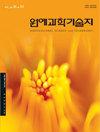“粉红安娜贝尔”绣球与“北极熊”绣球种间杂交受精后屏障及适宜培养时间的研究
IF 0.8
4区 农林科学
Q3 HORTICULTURE
Korean Journal of Horticultural Science & Technology
Pub Date : 2023-04-30
DOI:10.7235/hort.20230020
引用次数: 0
摘要
种间杂交是指将多种性状转移到另一种物种中,是扩大开花植物多样性的重要方法。由于各种因素的影响,形成种子和获得幼苗非常困难。一般来说,胚胎抢救策略可以克服受精后的障碍。本研究的目的是建立一个方案,以提高绣球花种间杂交的成功率,通过确定种子流产和最佳胚珠期存在受精后的障碍。将绣球与绣球杂交,从授粉后3周开始每周观察子房和种子。体外培养5株WAP胚珠。结果,卵巢似乎已经正常成熟。卵巢胚胎在4 ~ 5wap之间开始形成,在5 ~ 7wap之间发育。2905个培养的胚珠中有45个发芽,发芽率很低,只有1.6%。5 ~ 7 WAP的早期胚胎是胚胎形成和发育的早期阶段,发芽率低,发芽期长(平均23.3 d)。8wap培养的胚珠发芽率较高,发芽期较短,平均为11.6 d。在14 WAP时,种子萌发期(33 d)和胚珠塌缩明显增加。综上所述,13 ~ 14 WAP之间存在受精后屏障,8 ~ 12 WAP之间为种间杂交的最佳胚珠培养期。本文章由计算机程序翻译,如有差异,请以英文原文为准。
Investigation of the Post-fertilization Barrier and Appropriate Culture Time During the Interspecific Hybridization of Hydrangea arborescens ‘Pink Annabelle’ and H. paniculata ‘Polar Bear’
Interspecific hybridization, referring to the transfer of various traits into another species, is an important method to expand diversity in flowering plants. It is very difficult to form seeds and obtain seedlings due to various factors. Post-fertilization barriers can be overcome by embryo rescue strategies in general. The purpose of this study is to establish a protocol to improv the success of the interspecific hybridization of hydrangeas by identifying seed abortion and optimal ovule stages in the presence of post-fertilization barriers. Hydrangea arborescens and H. paniculata were crossed, and ovaries and seeds were observed every week from three weeks after pollination (WAP). Ovules were cultured in vitro from 5 WAP. As a result, it appeared that the ovaries had matured normally. Embryos in the ovary started to form between 4 and 5 WAP and developed between 5 and 7 WAP. Forty five out of 2,905 cultured ovules germinated, indicating a very low germination rate of 1.6%. Early embryos from 5 to 7 WAP, the early stages of embryo formation and development, had a low germination rate and a long germination period (average of 23.3 days). The germination rate was relatively high and the period for germination (average 11.6 days) was relatively short in cultured ovules from 8 WAP. A sharp increase in the germination period (33 days) and ovule collapse were observed at 14 WAP. In conclusion, post-fertilization barriers appeared to occur between 13 and 14 WAP, and the optimal period for the culturing of ovules was between 8 and 12 WAP for interspecific hybridization (H. arborescens x H. paniculata).
求助全文
通过发布文献求助,成功后即可免费获取论文全文。
去求助
来源期刊
CiteScore
2.00
自引率
0.00%
发文量
0
审稿时长
1 months
期刊介绍:
Horticultural Science and Technology (abbr. Hortic. Sci. Technol., herein ‘HST’; ISSN, 1226-8763), one of the two official journals of the Korean Society for Horticultural Science (KSHS), was launched in 1998 to provides scientific and professional publication on technology and sciences of horticultural area. As an international journal, HST is published in English and Korean, bimonthly on the last day of even number months, and indexed in ‘SCIE’, ‘SCOPUS’ and ‘CABI’. The HST is devoted for the publication of technical and academic papers and review articles on such arears as cultivation physiology, protected horticulture, postharvest technology, genetics and breeding, tissue culture and biotechnology, and other related to vegetables, fruit, ornamental, and herbal plants.

 求助内容:
求助内容: 应助结果提醒方式:
应助结果提醒方式:


